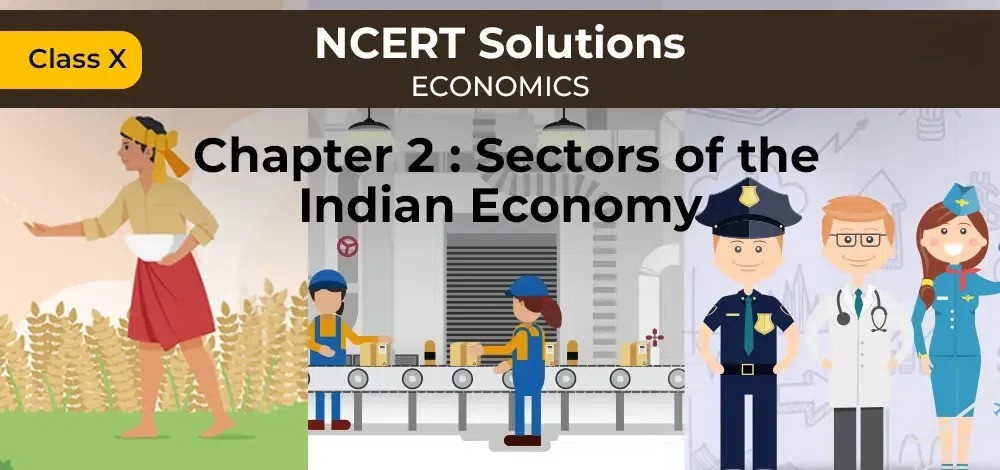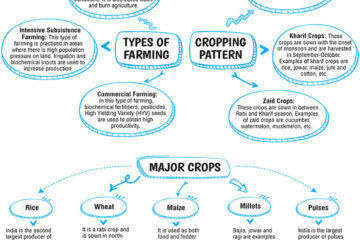I. SECTORS OF ECONOMIC ACTIVITIES:
i. Primary sectors: Activities that are undertaken by directly using natural resources. When we produce a good by exploiting natural resources, it is an activity of the primary sector.
- The primary sector forms the base for all other products that we subsequently make.
- Since most of the natural products we get are from agriculture, dairy, fishing, and forestry, this sector is also called agriculture and related sectors.
ii. Secondary sectors: The secondary sector covers activities in which natural products are changed into other forms through ways of manufacturing that we associate with industrial activity.
- This sector gradually became associated with the different kinds of industries that came up, it is also called as industrial sector.
iii. Tertiary sector: These are activities that help in the development of the primary and secondary sectors.
- These activities, by themselves, do not produce a good but they are an aid or a support for the production process.
- Since these activities generate services rather than goods, the tertiary sector is also called the service sector.
The above-mentioned activities, though grouped into three different categories, are highly interdependent.
II. COMPARISON OF THREE SECTORS OF THE ECONOMY (THROUGH PRODUCTIVITY AND POPULATION):
i. As thousands of economic activities are going around in all three sectors, it is almost impossible to take account of every such activity so to tackle this problem the values of goods and services are to be used rather than adding up the actual numbers.
- For example, a farmer who sells wheat to a flour mill for Rs 8 per kg.
- The mill grinds the wheat and sells the flour to a biscuit company for Rs 10 per kg.
- The biscuit company uses flour and things such as sugar and oil to make four packets of biscuits.
- It sells biscuits in the market to consumers for Rs 60 (Rs 15 per packet).
- Biscuits are the final goods, i.e., goods that reach the consumers.
ii. In Comparing and calculating various sectors of the economy, the value of the goods is used and not the quantity.
- Not every good (or service) that is produced and sold needs to be counted.
- The value of only “final goods and services” is to be included/calculated.
- The value of intermediate goods and services is not, included/calculated.
- The value of intermediate goods and services is already in final goods and services.
iii. Why are only final goods and services counted?
- As intermediate goods are used up in producing final goods and services, the value of final goods already includes the value of all the intermediate goods that are used in making the final goods.
iv. the value of final goods and services produced in each sector during a particular year provides the total production of the sector for that year.
v. the sum of the total production in the three sectors is called the Gross Domestic Product (GDP).
- The higher the GDP, more bigger the economy of the country is.
vi. Historical Change in sectors:
- At the initial stages of development, the primary sector was the most important sector of economic activity in a country.
- With the innovation in farming methods, the agriculture sector began to produce much more food than before.
- People started working in industries.
- Some people also get involved in transportation.
- Gradually, the Secondary sector became the most important in the economy and provided employment.
- Different industries related to food processing, equipment making, and textiles come in large numbers.
- This led to the start of services such as banking, health, education, etc.
- The service sector has become the most important sector in terms of total production and started employing more people.
vii. Contribution to GDP:
- In 1973-74, the primary sector contributed the maximum to the GDP.
- But in 2013-14 when tertiary sector contributed the maximum in GDP. Now the question is Why? There are various factors behind this.
viii. Factors behind the shift in contribution to GDP:
- The development of agriculture and industry leads to the development of services such as transport, trade, storage, and banking.
- The greater the development of the primary and secondary sectors, the more would be the demand for such services.
III. WHERE ARE MOST OF THE PEOPLE EMPLOYED?
i. In the period from 1973 – 74, 40% is contributed by the primary sector in the GDP of the country.
- The secondary sector contributed only 12% and 48% contributed to the tertiary sector.
- Employment percent during 1972-73, 74% of people of India are engaged in the primary sector while only 15% are involved in the tertiary sector.
ii. In 2013-14, the percentage of contribution of the tertiary sector to the GDP of the country increased and reached 67%.
- The primary sector reduced to only 12%.
- The primary sector continued to be the largest employer during 2011-12.
iii. Disguised unemployment: this is a situation of underemployment where people are working but all of them are made to work less than their potential. An example is agriculture where a family of five works in the field, where each of the members is doing some work but no one is fully employed.
- More people engaged in agriculture than the necessity.
- This kind of underemployment is hidden in contrast to someone who does not have a job and is visible as unemployed, it is also called disguised unemployment.
A. HOW TO CREATE EMPLOYMENT?
i. Granting Loans at lower interest Rates.
ii. Investing in infrastructure such as Building a dam at a suitable place.
iii. Increasing efficiency of transportation and Storage.
iv. Promoting small-scale Industries such as mills, and honey collection centers.
v. Emphasis on Education and Training Center.
vi. Identifying the Potential of an area. For example, an area can be developed as a tourist site.
vii. Government Welfare Schemes like making wells or pumps near farms, providing electricity, and building hospitals.
MGNREGA:
i. The central government in India made a law implementing the Right to Work in 625 districts called the Mahatma Gandhi National Rural Employment Guarantee Act 2005 known as MGNREGA 2005.
ii. Under MGNREGA 2005:
- In rural areas, all those who can, and need work are guaranteed 100 days of employment in a year by the government.
- If the government fails in its duty to provide employment, it will give unemployment allowances to the people.
DIFFERENCE BETWEEN ORGANISED AND UNORGANISED SECTORS:
i. Organized sectors are registered by the government and have to follow its rules and regulations.
- Workers in the organized sector enjoy the security of employment.
- Organized sector workers are expected to work only a fixed number of hours.
- Organized sector workers get paid leave, payment during holidays, provident fund, gratuity, medical benefits, etc.
- Examples of organized sectors are government employees, banks
ii. Unorganised sectors are largely outside the control of the government.
- In the unorganized sector, there is no job security.
- In the unorganized sector, there is no pay for overtime work.
- Paid leave, payment during holidays, provident fund, gratuity, medical benefits, etc are not given in the unorganized sector.
- Examples of unorganized sectors are home tutors, and people working in small general stores.
B. SECTORS IN TERMS OF OWNERSHIP: PUBLIC AND PRIVATE SECTORS:
i. Public sector: The government owns most of the assets and provides all the services.
- Service motive.
- Example: Railways or post office.
ii. Private sectors: Ownership of assets and delivery of services is in the hands of private individuals or companies.
- Profit motive.
- Example: Tata Iron and Steel Company Limited (TISCO) or Reliance Industries Limited (RIL).




